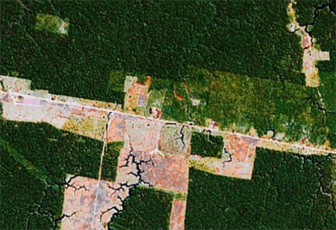Island biogeography theory has been surpassed when it comes to forest fragmentation
Island biogeography theory doesn’t explain biodiversity changes in forest fragments
mongabay.com
July 28, 2008
Island biogeography theory, the idea that fragmented ecosystems have lower species richness per unit of area compared with contiguous habitats, has served as a useful conceptual model to understand the effects of habitat fragmentation but fails to explain the complexities of change in isolated forest fragments, according to a synthesis published last month in the journal Biological Conservation.
The paper, authored by William F. Laurance of the Smithsonian Tropical Research Institute and the Biological Dynamics of Forest Fragments Project at the National Institute for Amazonian Research, argues that long-term research into forest fragmentation in the Brazilian Amazon has taken scientists well beyond the generalizations offered by island biogeography theory (IBT).
“Island biogeography theory revolutionized the way ecologists think about the world, and it taught us a great deal about the effects of reserve size and isolation on species survival,” Laurance told mongabay.com. “But ecologists have now moved far beyond IBT.”

A fragment of forest surrounded by cleared areas in the Amazon near Manaus. Image courtesy of Google Earth. Laurance says that fragmentation is destabilizing forest dynamics by driving high turnover rates among tree species as large trees lose out to small, fast-growing species. As large trees die off, the canopy thins, drying the forest and increasing the its vulnerability to agricultural fires set in surrounding areas. |
“It’s an elegant conceptual model, but it fails to consider crucial things like edge and matrix effects and many other realities that affect fragmented ecosystems.”
Laurance writes that IBT falls short in a number of areas, including how community composition in fragments changes over time, which species are most vulnerable to fragmentation, the impact of edge effects, the importance of the matrix of modified vegetation surrounding fragments, the effects of fragmentation itself of ecosystem functioning, and the role of anthropogenic changes on biodiversity in forest islands.
He notes that IBT is limited by the nonrandom nature of forest isolation; an ignorance of edge and matrix effects and community-level changes; and co-variance between habitat loss and fragmentation effects. He says that IBT also fails to account for that impact of fragmentation on ecosystem processes including forest dynamics, nutrient cycling, carbon storage, and forest-climate interactions. Further, Laurance highlights the significance of environmental synergisms in effecting species richness in forest fragments.
“In the real world, habitat fragments are not merely reduced and isolated; they are also frequently affected by other perturbations that may interact additively or synergistically with fragmentation,” he writes. “Forest fragments in the tropics are often selectively logged, degraded by ground fires, and overhunted—changes that can dramatically alter fragment ecology.

Fragmentation in the Brazilian Amazon. More than two-thirds of the world’s remaining forests are fragmented. Image courtesy of NASA. |
“In coming decades, anthropogenic climate change may emerge as an increasingly important threat to fragmented ecosystems, especially if droughts, storms, and other rare weather events increase in frequency or severity,” he continues. “Thus, forest fragments and their biota are sometimes subjected to a withering array of environmental pressures that may be episodic or chronic in nature. A paradigm like IBT that considers only changes in fragment size and isolation while ignoring other anthropogenic effects is dangerously inadequate for conservation purposes. It is also inadequate from a scientific perspective. A more realistic view of fragmented landscapes is one that explicitly recognizes the potential for interacting environmental changes to amplify and alter the ecological impacts of habitat fragmentation.”
William F. Laurance. Theory meets reality: How habitat fragmentation research has transcended island biogeographic theory. Biological Conservation 141 (2008) 1731-1744














